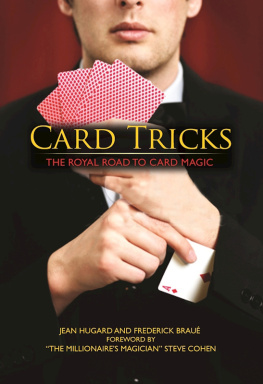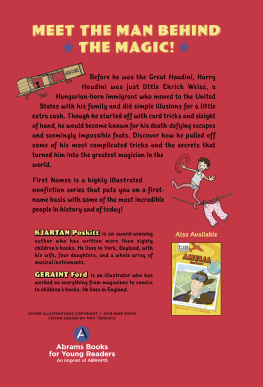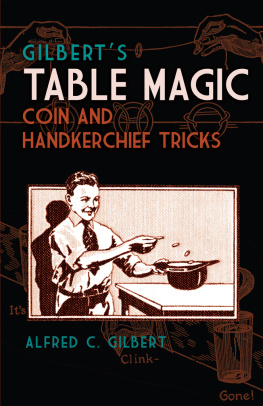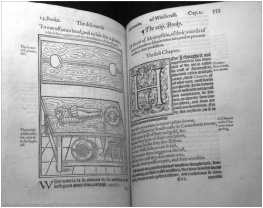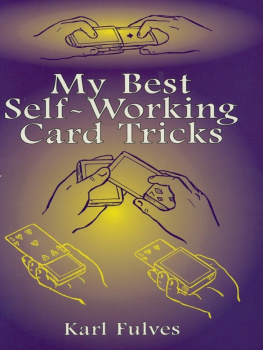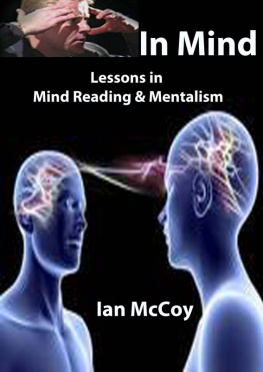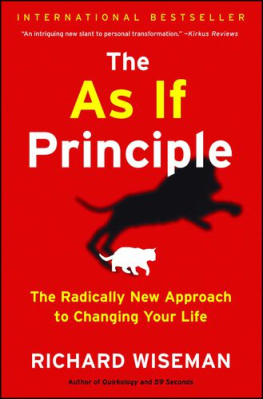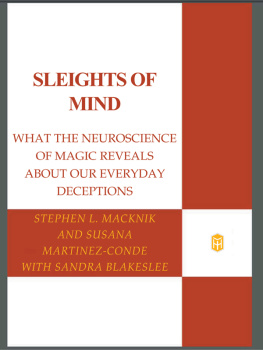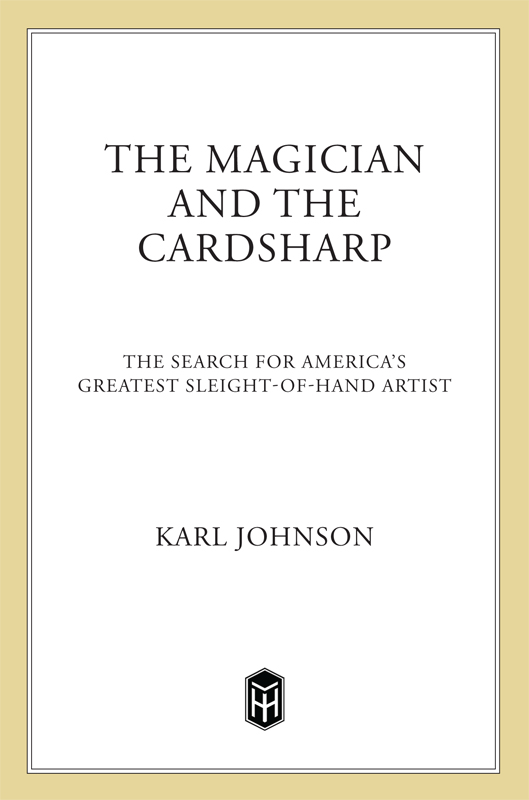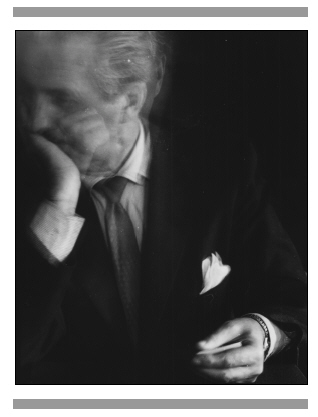

The author and publisher have provided this e-book to you for your personal use only. You may not make this e-book publicly available in any way. Copyright infringement is against the law. If you believe the copy of this e-book you are reading infringes on the authors copyright, please notify the publisher at: us.macmillanusa.com/piracy.
Contents
THIS BOOK IS DEDICATED, WITH MY LOVE AND MY LIFE, TO MIRA
His magic is performed with complete naturalness, its artistry that of the art that conceals art. The consummate skill and technique is there but it is never displayed; it is, on the contrary, so carefully hidden that the performer is applauded not for his nimble-fingered dexterity but because he has, with the effortless ease of a real magician, exhibited a feat of what must be real magic.
Jean Hugard and Frederick Braue, Expert Card Technique, Third Edition
PERFECT
To Dai Vernon, Amador Villasenor was a lucky draw, like turning up three aces in the last hand on a losing night. To the cops in Wichita, who had searched for him for three long years, Villasenor was a gambler, a cardsharp, a thief, and a killer.
Though perhaps not a first-degree murderer. Villasenor swore he had acted in self-defense, and the police and his jailers believed what he had to say. The distinction was a technicality, maybe, but his freedom depended on it. Villasenor had, after all, taken a mans life. He had confessed to shooting one Benito Leija and leaving him to meet his maker in the grit of a Wichita alleyway back in the red-hot summer of 1929. He said he had even watched as Leijalike himself, a young Mexican in his twenties, a gambler well accustomed to the feel of cards and dicehad staggered off the sidewalk outside Manuel Garcias poolroom in Wichitas North End, contemplating his speedily approaching end. Villasenor had jumped in his car on that July evening and bolted out of the city as Leija pitched forward from his knees into a pool of his own blood.
Vernon, who had just come to Wichita, knew little of what had landed Villasenor in the citys Sedgwick County Jail, where he was meeting him on a wet winter night during the first gloomy week of February 1932. The crime had happened long before Vernon arrived in Wichita and it didnt really interest him. To Vernon, Villasenors predicament was a scrape like a million others, a gambling mix-up, he called it. Vernon certainly wasnt one to make a hobby of murder. That was not his line.
What roused Vernon on this chilly evening was the possibility he might learn something from Villasenor he could use in his magic. Vernon was a magician, an artist. Magic was his obsession. It was what he cared about more than anything else. For three decades, Vernon, now thirty-seven, had been consumed by magic. At times, it possessed him. It was what he puzzled over, theorized about, dreamed of.
Magic would keep Vernon up for days at a time with no thought of food or rest. Magic softened these hard times of the Depression. Magic made his dull days cutting silhouettes in a department store in this wheat-and-oil town passable. He was a world away from the ritzy Park Avenue soirees where he had once been the featured attraction, but magic made even that bearable. It was what allowed Vernon to walk blithely into a jail to shake hands with a killer. Vernon would smile and follow the devil himself if it meant he could bring back something, a sleight, a ruse, a line of patter, that he could use in his art.
In the Twenties magic had offered audiences a cocktail of glamour and glitz, elegance and escape, to chase away the humdrum workaday world. To most of the great illusionists of that golden era, bigger was better. Magic, to those veterans of the slam-bang vaudeville tours, meant stage spectacles on a grand scale. The tuxedoed, ministerial Howard Thurston, then considered the most popular magician in the world, offered up his portentous Wonder Show of the Universe with ever-more-elaborate levitations and disappearances, including the Vanishing Whippet Automobile, packed with seven gorgeous young beauties. Horace Goldin, known as the Whirlwind Illusionist, jammed so many effects into his dizzying act that he had stopped speaking on stage altogether lest he slow down the pace. Silence is Goldin, a British competitor had quipped. But to Dai Vernon, spectacle had little to do with magic. To Vernon, the magic was not in the size of the stage or the number of tricks on the bill or the box-office receipts.
Vernon had first started popping up at New Yorks fabled magic shops around the end of World War I. He was from Canada, dashing and cultured, and he handled cards with a gentle grace, coaxing such startling effects from them that even the most experienced magicians were flummoxed. In short order, he was ushered into the hallowed back rooms where only the most elite practitioners of the ancient art were allowed to gather.
Quickly, quietly, he had begun to steer his art in a new direction. He was as different from an old-style illusionist as an Impressionist was from a sign painter. Rather than larger and faster, he preferred to make magic that seemed more casual, and thus more natural. And as he became more well-known, a small group of nimble-fingered sleight-of-hand artists, who came to be dubbed the Inner Circle, gathered around him. They were a quiet band of artistic assassins killing off the old Victorian ways of magic. Vernon was the Lenin to the rest of these revolutionaries. He became magics Picasso, its Hemingway, its Duke Ellington.
Vernon had little interest in the old stage ruses. He believed that sleight of hand and psychological subtlety far surpassed the hidden mirrors and wires used by conventional illusionists. To him, the proper stage for real magic was not the expanse of the vaudeville boards, but the unadorned human hand, held out just before his spectators eyes. And the best props were not floating women or disappearing automobiles, but bits of string, colorful silks, cups and balls, coins and cards. Always cards.
Cards were Vernons first love. They were the choice instrument for his audacious style of magic. He moved away from the pick-a-card tricks that always started the same way, preferring instead to have people merely think of a card without touching the deck. Then he would look them in the eye and tell them the exact card they were thinking of. He replaced the dull Victorian patter with sharp, modern tales peppered with slang. With a rakish grin, the smoke of his cigarette curling up around his dark eyes, Vernon would deftly maneuver the cards with his long, elegant fingers, improvising with them the way a jazz musician might with his cornet, beginning an effect without knowing exactly where he was going to take it.
The Wichita jail was an imposing building that held a small towns worth of prisoners, over eight hundred, from murderers down to bad-check writers. Since the Depression had tightened its grip and winter had settled, a new class of prisoner had begun to appearhobos, drunks, and other down-and-outers looking for a hot meal and a warm, dry place to stay the night. Vernons friend Faucett Ross, a fellow magician who had gotten the tip about a gambler in the lockup who was a whiz with a pack of cards, went in with him. After Ross gave the inmates some smiles by doing a few tricks, the guards went down to the cell block to fetch Amador Villasenor.



